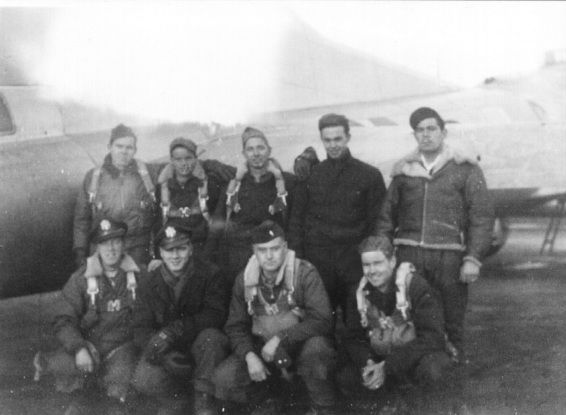


|
LT Hull's crew Standing (L to R): Unknown, SGT Hatler, unknown, SGT Richard Stevenson, SGT Buford Addington. Front (L to R): LT Les Hull, LT Murray Hunter, LT Bill Roberts, LT J. R. Hardy. (courtesy of Bill Roberts, Jr.). Les Hull's War Diary Bill Roberts' War Diary |
This is the true story of a B17 crew on a combat raid to Merseberg, Germany on 11/02/44. Soon after take-ff the No. 4 engine began smoking, but not too bad. There was a strong smell of gasoline in the radio room, waist and tail The waist gunner got in the ball-turret and looked for a leak underneath, but to no avail. From the radio room the ball-turret gunner discovered the gasoline coming out of the filler cap of No. 3 engine. The gasket was probably bad or the chain was caught under the cap when it was replaced. By keeping the tank low on fuel only about 400 gallons was lost. Everything went well for a while, until another B17 flying low and a little to the right pulled its nose up and banked fast to the left. The co-pilot saw it coming just in time to pull his plane up and let the other one slide under. The wings almost touched. The pilot, not knowing what the co-pilot was doing, grabbed the controls and shoved the nose down just in time to avoid hitting the plane above. He knew being hit the air meant, as his plane was hit on a previous mission and the entire crew had to bail out. Soon after crossing the enemy coast No. 2 engine began giving trouble. It got constantly worse and due to the vibration the pilot shut if off. The supercharger was out and it was doing little more than wind milling anyway. The No. 1 engine had been giving trouble and lost all power. The engineer changed the amplifier and regained the power only for a short time. Due to internal damage the oil pressure dropped off and the temperature went up. The extra power exerted on the other three engines was note enough to hold formation and it caused the No. 1 prop to run away. This was just a little east of Brunswick. The pilot told the bombardier to salvo the bombs and maybe he could sty in formation on over the target. The bombs were released, but No. 1 had to be feathered. Oil from Nos. 1 and 2 completely covered the wing and horizontal stabilizer. Meanwhile Nos.3 and 4 were smoking and throwing a lot of oil and the altimeter showed a loss of 250 ft per minute. The pilot asked the co-pilot what he thought and they decided to turn back. From 26,000 feet they figured they had a chance to get to the coast before going down. The pilot could not contact the formation. His plane was flying alone at 120 mph unescorted. Our fighters knocked down a lot of Jerries that day, which probably accounted for them not attacking us. The navigator kept changing course to avoid flak guns. The guns at Hanover came the closest. There was a solid undercast which made navigating difficult. The pilot called each crew member and asked him what he wanted to do; that is, bail out, crash-land in Germany, or try to make it to the coast and ditch in the North Sea. Each one said they had rather ditch. The radio-operator sent out a call for a fighter escort and was answered by a German who wanted to take a fix on his position. He waited awhile and called again. The German answered again, but shut up when the radio-operator challenged him. This time the home field was contacted and fighters were sent out, but they were unable to find the crippled B17. The radio-operator sent "Thanks for the fighters" in plain code which the German probably received and heeded. The navigator hit the corridor that they came in on perfectly. There were a few holes in the undercast at the coast and it was wonderful to look down and see the North Sea below. Even an icy bath was better than going down in Germany. Numbers 3 and 4 engines were still smoking like locomotives and throwing a lot of oil, but due to atmospheric conditions the loss in altitude was reduced considerably. These engines were in such bad shape, it was impossible to give them full power. They had pulled the big plane about 700 miles already. It was decided to get as near the English coast as possible before ditching. There was little danger of an enemy attack now, so the tail gunner came up to the waist and helped prepare for ditching. Just as the English Coast was sighted, No. 3 engine went out and had to be feathered. The pilot gave the order to throw everything overboard. Only the extra clothing was kept to be used as padding when they hit the water. They were flying on one engine at bout 7,000 feet and losing altitude steadily. About 15 minutes later the coast was crossed, an airfield spotted, and the pilot made a perfect landing. It was good to be on solid ground again. The magnificent job of flying by the two pilots and the navigating by the navigator is almost unbelievable. With the help of God, they were able to bring this plane back to England. A few hours later they were picked up by a plane from their own field and flew home. The efficiency of the English Air-Sea Rescue must not be overlooked. The radio operator contacted them and they sent out several rescue boats as well as planes carrying motor launches under their bellies to be dropped to the crew if they had to ditch. They do a marvelous job of Rescue work. B. H Addington NOTE: LT Hull was awarded the Distinguished Flying Cross for this mission. |
| CREW INFO | |||||
| Name | Rank | Position | First Mission | Last Mission | Status |
| Lesley B. Hull | LT | Pilot | 09/25/44 | 02/21/45 | WIA, DFC, completed tour, 35 missions. |
| William A. Roberts, Jr. | LT | Pilot | 09/25/44 | 02/21/45 | Completed tour, 35 missions. |
| Murray H. Hunter | LT | Navigator | 09/21/44 | 02/09/45 | Completed tour, 35 missions. |
| John R. Hardy | LT | Bombardier | 09/25/44 | 02/21/45 | 32 missions. |
| Vernon P. Hatler | SGT | Flight Engineer | 09/25/44 | 02/19/45 | Completed tour, 35 missions. |
| Wesley W. Thalender | SGT | Radio Operator | 09/25/44 | 02/19/45 | Completed tour, 35 missions. |
| Buford H. Addington | SGT | Waist | 09/25/44 | 02/21/45 | Completed tour, 35 missions. |
| Howard Lowe | SGT | Armorer/Ball | 09/25/44 | 02/21/45 | Completed tour, 35 missions. |
| John M. McManus | SGT | Waist | 09/25/44 | 12/29/44 | 30 missions. |
| Richard W. Stevenson | SGT | Tail | 11/16/44 | 02/21/45 | 30 missions. |
| MISSION INFO | |||||
| MISSION | DATE | NAME | ID | S/N | TYPE |
| Sudbury, England | 09/09/44 | B17G | |||
| 081 | 09/25/44 | Pursuit of Happiness | TH | 931 | B17G |
| 083 (abort/collision) | 09/27/44 | TM | 43-38005 | B17G | |
| 086 | 10/03/44 | TB | 43-37835 | B17G | |
| 087 | 10/05/44 | Batchelor's Delight | TR | 43-38027 | B17G |
| 088 | 10/06/44 | TL | 43-38040 | B17G | |
| 090 | 10/09/44 | Winged Virgin | DM | 43-38149 | B17G |
| 091 (abort) | 10/14/44 | Smokey Stover | TD | 43-37916 | B17G |
| 093 | 10/17/44 | B17G | |||
| 095 | 10/19/44 | TP | 43-37992 | B17G | |
| 096 | 10/22/44 | The Prowler | TK | 43-37937 | B17G |
| Practice | 10/24/44 | B17G | |||
| 098 | 10/26/44 | B17G | |||
| 099 (abort) | 10/30/44 | The Prowler | TK | 43-37937 | B17G |
| 100 | 11/02/44 | The Blue Fairy | TJ | 43-37942 | B17G |
| 101 | 11/04/44 | Smokey Stover | TD | 43-37916 | B17G |
| 103 | 11/06/44 | The Prowler | TK | 43-37937 | B17G |
| 106 | 11/16/44 | The Prowler | TK | 43-37937 | B17G |
| 107 | 11/21/44 | The Prowler | TK | 43-37937 | B17G |
| 108 | 11/25/44 | The Prowler | TK | 43-37937 | B17G |
| Engineering flight | 12/13/44 | B17G | |||
| 117 | 12/23/44 | The Prowler | TK | 43-37937 | B17G |
| 120 | 12/28/44 | TS | 43-37928 | B17G | |
| 121 | 12/29/44 | The Prowler | TK | 43-37937 | B17G |
| 123 | 12/31/44 | B17G | |||
| 126 | 01/03/45 | B17G | |||
| 128 | 01/07/45 | The Prowler | TK | 43-37937 | B17G |
| 129 | 01/08/45 | The Prowler | TK | 43-37937 | B17G |
| 130 | 01/10/45 | The Prowler | TK | 43-37937 | B17G |
| 131 | 01/13/45 | The Prowler | TK | 43-37937 | B17G |
| 132 | 01/14/45 | The Prowler | TK | 43-37937 | B17G |
| 134 | 01/18/45 | The Prowler | TK | 43-37937 | B17G |
| 135 | 01/20/45 | The Prowler | TK | 43-37937 | B17G |
| 136 | 01/21/45 | The Prowler | TK | 43-37937 | B17G |
| 137 | 01/28/45 | The Prowler | TK | 43-37937 | B17G |
| 139 | 02/01/45 | The Prowler | TK | 43-37937 | B17G |
| 140 | 02/03/45 | The Prowler | TK | 43-37937 | B17G |
| 141 | 02/06/45 | The Prowler | TK | 43-37937 | B17G |
| 142 | 02/09/45 | The Prowler | TK | 43-37937 | B17G |
| 143 | 02/14/45 | The Prowler | TK | 43-37937 | B17G |
| 144 | 02/15/45 | The Prowler | TK | 43-37937 | B17G |
| 146 | 02/17/45 | The Prowler | TK | 43-37937 | B17G |
| 147 | 02/19/45 | The Prowler | TK | 43-37937 | B17G |
| 148 | 02/21/45 | B17G | |||
| Completed 37 Missions | |||||
| Created 09/10/99 | Modified 12/23/16 |
Copyright © 1998-2025, 486th Bomb Group Association. |
|